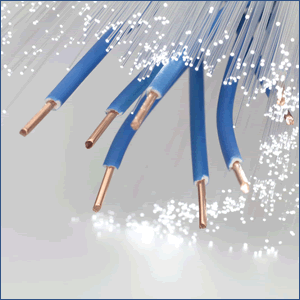Why We Need Copper AND Fiber
From wet silk thread to modern superconducting ribbon, interconnect technology has advanced along with the related electronic technology as it is critical to an electrical system’s operation. Add to that the realm of optical fiber, and you have a huge marketplace of mixed applications, technologies, and services.
 With wireless technologies – both signal- and power-oriented – dominating the attention of the marketplace, it may appear that any debate on cables is akin to a group of Farriers arguing about what is the best kind of horseshoe nail to use. While the analogy may appear apt, it is only applicable in that if the nail comes out, the shoe fails.
With wireless technologies – both signal- and power-oriented – dominating the attention of the marketplace, it may appear that any debate on cables is akin to a group of Farriers arguing about what is the best kind of horseshoe nail to use. While the analogy may appear apt, it is only applicable in that if the nail comes out, the shoe fails.
The vaunted wireless Cloud that has the world gushing is, in reality, a huge iceberg of electronics, with the tiny devices and wireless gadgets we are enamored with at the top and the huge cabled infrastructure below, like the Morlocks under the Eloi. The person playing “World of Tanks” on their cell phone has barely an inkling of the effort required under the surface to ensure he doesn’t write hate mail to the service provider over lag. The focus is on the wireless link, but the chain only starts there.
From the high-voltage cables that carry the power that forms the backbone of the grid; to the massive intermediate power and signal infrastructure; to the vast number of power, signal, and hybrid cables involved in the “final mile”; there are going to be wires and cable for the forseeable future, and that includes the related and required connector technologies. According to research firm IDC, the IoT will become a $7 trillion business by 2020, and a significant amount of that money will be spent on the wired infrastructure.
Wire and cable have been around since electricity was discovered; once we had it, we had to figure out a way of moving the stuff around. From wet silk thread to modern superconducting ribbon, interconnect technology has advanced with the related electronic technology as it is critical (by definition) to an electrical system’s operation. Add to that the realm of optical fiber, and you have a huge marketplace of mixed applications, technologies, and services.
Tech Overview
Let’s start with metal wire; metal wire was the beginning of the commercialization of power. From there we go to signal wire, which at first (the aforementioned telegraph) was actually a hybrid wire, the signal being created by intermittent connection of the power line. Once insulation came along and cables could be created, the industry exploded. Then optical fiber revolutionized signal technology and now is looking to challenge metal wire in the area of power distribution as well.
In the area of signal transmission, fiber currently has cable beaten hands down (see Figure 1), although there are rays of hope for continued competition from cable. In 2014 Alcatel-Lucent set a broadband speed record of 10Gb/s using traditional copper telephone lines and a prototype technology. Now, the G.fast DSL standard for local loops shorter than 500M is capable of delivering gigabit speeds (and possibly multi-gigabit with “XG-FAST”) over traditional copper telephone lines. Even if this technology gains traction, we won’t see copper carrying that kind of bandwidth until the related connector and installation infrastructure has been implemented.

Figure 1: Maximum speeds of different internet infrastructures
(Source: California Legislative Analysis Office
Fiber’s biggest issues in signal transmission involve its high installation and modification cost and related issues of transceiver reliability and maintenance. This leads many to use metal cable for the final mile and user interconnect. As these costs continue to decrease, fiber will be more palatable for use as an end-to-end solution. There are still quite a few “fiber optic” data infrastructures with a lot of copper at each end.
In the area of power transmission, it appears metal-based wire beats fiber. Electrical power carried over metal is relatively cheap and easily scalable, and the system doesn’t require conversion from one form of energy to another. Optical power transmission has a few unique advantages over metal wires, a major one being immunity to electromagnetic interference. Being able to snake a power/signal optical fiber to a sensor packet in a harsh electromechanical environment without having to worry about EMI is a significant advantage.
Just as copper is fighting in the signal arena, fiber is now pushing power. There have been some impressive demonstrations of energy delivered over optical fiber recently, demonstrating that fiber could someday be a complete solution for both power and signal and a true competitor to copper at every level.
One company interested in the space for low-power applications is LaserMotive. It is developing both wireless and fiber-based power delivery systems, targeting small sensors and other intelligent remote devices. Its Mark 1 Micro-PoF can deliver 10 watts of regulated DC power at 5V (3.3V or 12V optional) over a fiber link to a 580-gram receiver at a distance of up to 500 meters (10 meters is the default).
At the research level, Motoharu Matsuura, Hidehito Furugori, and Jun Sato at the University of Electro-Communications in Tokyo have demonstrated the ability to supply 60W over a 300-meter test fiber system. These are very good results, promising to bring optical power into medium-range applications like remote motor control and other energy-demanding remote automation apps.
Another practical example of optical fibers displacing metal leads is in electronics test. Optical test leads have been used for a while to test optical systems, but now some companies are using the high isolation of optical to make more accurate measurements of non-optical systems. For example, Tektronix’s IsoVu technology offers complete galvanic isolation between a device under test (DUT) and an oscilloscope through the use of electro-optical sensors, and is presented as the first measurement solution capable of accurately resolving high-bandwidth differential signals in the presence of large common-mode voltage.
Neither wire nor optical technology will displace the other for the foreseeable future and, frankly, neither needs to; engineers always benefit when there are multiple solutions to a problem.
Louis Edwards is a freelance contributor to Connector+Cable Assembly Supplier.
[hr]
Additional information on the fiber optic connector and structured cabling markets can be found in these research studies from Bishop & Associates:
Fiber Optic Connector Market 2015-2020
Structured Cabling and Connectivity Market




